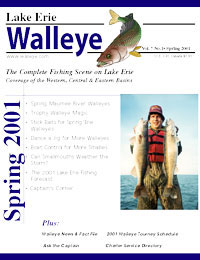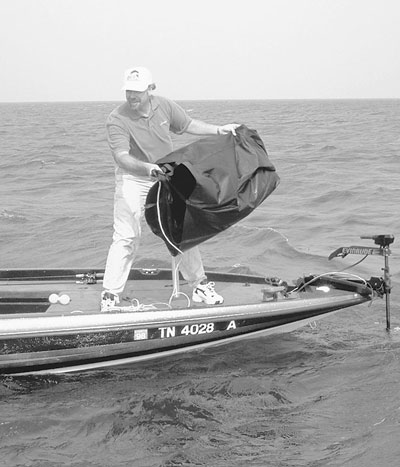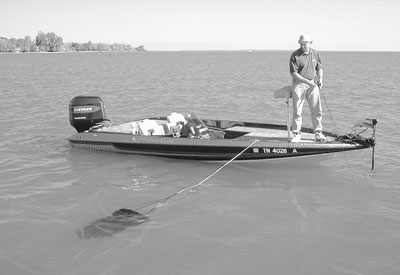Critical Boat Control
Produces
More Smallmouths
by Mark Hicks

Order Lake
Erie Walleye Magazine
Three Information-Packed Issues for only $10.00
Delivered to your doorstep every March, June and September
|
Critical Boat Control
Produces |
|
T
he vast, open expanses of Lake Erie, coupled with its extensive off shore smallmouth habitat, present special challenges to
anglers. Whether you fish from a bass boat or a 40-foot cruiser, many of the
same boat control principles apply.
to
anglers. Whether you fish from a bass boat or a 40-foot cruiser, many of the
same boat control principles apply.
Boat control separates consistently successful Lake Erie smallmouth anglers from those who often endure lackluster outings. Even if you determine where smallmouths are located and select the right lures or bait rigs, haphazard boat control drastically reduces your catch.
DRIFTING
When the wind kicks up, many Lake Erie bass anglers stay on shore to avoid rough boating and strenuous fishing conditions. While you should never venture out in truly dangerous weather, a stiff breeze frequently puts smallmouths on the feed. No fisherman is more in tune to this fact than Jeff Snyder, a career bass angler from Massillon, Ohio.
Snyder excels when the wind blows by using its power to his advantage. He relies heavily on the drift-and-drag system he continually refines. This method works well for all boats and is regularly employed by charter captains.
DRIFT & DRAG
Drifting may sound like an aimless approach, and it can be if done improperly, but Snyder doesn’t merely cast his fate to the wind. His controlled drifts allow him to make big catches in blustery weather. Snyder harnesses the wind to push his boat while he drags a lure (usually a jig) behind.
The drift-and-drag is, without question, the easiest and one of the most effective methods for taking Lake Erie smallmouth bass. Some of the best drift fishing occurs in the spring and fall when smallmouths move up and scatter over near shore bottom structures in depths from about 12 to 25 feet.
"Most guys concentrate on the tops of the rises," says Snyder, "but the majority of the feeding takes place on the deeper flats. Smallmouths constantly move up and down, so I constantly move too."
In summer and early fall, claims Snyder, smallmouths roam in small
clusters. He reasons that drifting increases his odds for en countering
different groups of fish at this time, because his lures cover expansive
areas. An ideal situation is a wind that blows along the length of a ridge,
bottom contour or drop-off, permitting long drifts up to a quarter of a mile
or more.
countering
different groups of fish at this time, because his lures cover expansive
areas. An ideal situation is a wind that blows along the length of a ridge,
bottom contour or drop-off, permitting long drifts up to a quarter of a mile
or more.
Snyder motors upwind of a likely smallmouth structure and positions his boat so the wind pushes him over the most promising portion of it. He wheels the outboard one way as far as possible, using it as a rudder to swing the bow toward the wind. The electric motor is then pointed into the wind and used to nudge the bow over so the boat drifts broadside to the breeze. Larger fishing vessels, more typical on Lake Erie, generally are not equipped with electric motors, but they perform well with the drift-and-drag.
"I try to drift parallel to the edge of a drop-off as much as I can," he says. "I strive to put the center of the boat right on the contour."
If the wind is much stronger than about 15 miles per hour, Snyder sets out a sea anchor, also known as a drift sock. The drift sock, an essential tool for the drift-and-drag, slows the boat when the wind kicks up. More often than not, you’ll benefit by using this device. Slower drift speeds allow for lighter jigs and more tempting lure presentations. Attach the drift sock to a cleat in the middle of the boat or up near the bow, whichever location better holds the boat broadside.
A 20-inch diameter drift sock does nicely with boats up to 20-feet in most winds. Larger boats require socks on the order of 40-inches in diameter. Under extremely windy conditions, put out two or more socks or expand an adjustable sock.
If Snyder’s initial drift doesn’t produce, he makes ensuing drifts shallower or deeper until he starts getting strikes. He then concentrates on the productive depth, making repeated drifts over the same contour or fishing other structures nearby.
"Let the boat do the work," he advises. "Just keep the lure in the water, dragging and skipping over the rocks. You’ll know when a bass nails it."
CAST AHEAD
OF THE DRIFT
You may effectively combine casting with drifting, as long as you ....
........ to complete this article . For just $10.00/year you'll enjoy all of our latest issue of Lake Erie Walleye magazine. Plus, you'll have online access to past issues of the magazine with hundreds of great articles from the Lake Erie Walleye Magazine Archives!
Lastly, we'll mail this issue plus the next two issues directly to your home.
You can also call our toll free number at 1-800-347-4519 to subscribe today!